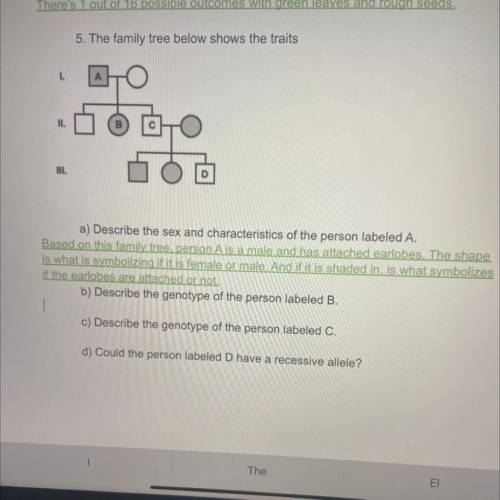5. The family tree below shows the traits
(Picture)
b) Describe the genotype of the person...

Biology, 30.04.2021 17:40 2005AngelMoore
5. The family tree below shows the traits
(Picture)
b) Describe the genotype of the person labeled B?
-please answer
c) Describe the genotype of the person labeled C?
-please answer
d) Could the person labeled D have a recessive allele?
-please answer
Thank you


Answers: 3


Other questions on the subject: Biology

Biology, 21.06.2019 16:00, caitlin89
Elements and compounds are pure substances that cannot be broken down physically into a simpler substance. a physical change doesn’t break the bonds between atoms of a substance or form new ones. compounds can be broken down by a chemical change. a chemical change breaks chemical bonds and/or forms new ones between atoms of a substance. what simple substance would a compound break into? the basic elements that make it up! for example, if you passed a very strong electric current through water you’d break the chemical bonds in water and be left with oxygen and hydrogen. which of the following is an example of a chemical change? a separating water into different glasses b breaking frozen ice cubes with a hammer c running an electric current through water d boiling water to evaporate it on a stove
Answers: 2

Biology, 21.06.2019 20:00, annapittbull12
Chlorophyll is found in plant leaves and absorbs light from the sun to enable plants to perform photosynthesis. magnesium is an important component of chlorophyll. the concentration of magnesium ions is higher in the root-hair cells of plants than in the soil. which mechanism of ion uptake would best enable a plant to produce a steady supply of chlorophyll? osmosis diffusion passive transport active transport
Answers: 1

Biology, 21.06.2019 20:00, anthonyjackson12aj
Which of the following matches the organisms described with the correct domain? a. bacteria--unicellular, eukaryotic organisms with cell walls that do not contain peptidoglycanb. archaea--multicellular, eukaryotic organisms that do not have cell wallsc. eukarya--single-celled and multicellular organisms, with a defined nucleus and a variety of nutritional sourcesd. bacteria--unicellular, eukaryotic organisms that always lack cell walls
Answers: 1

Biology, 22.06.2019 05:00, perezshayla56
I’m stuck on this question cuz i’m stupid sksksksk
Answers: 2
You know the right answer?
Questions in other subjects:


English, 28.09.2019 10:30

Mathematics, 28.09.2019 10:30



Mathematics, 28.09.2019 10:30

Mathematics, 28.09.2019 10:30


Mathematics, 28.09.2019 10:30

Mathematics, 28.09.2019 10:30



